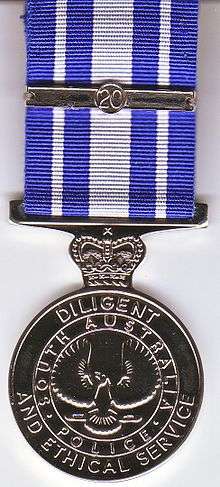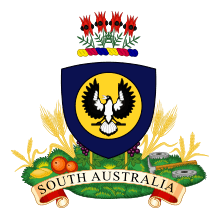South Australia Police
| South Australia Police | |
|---|---|
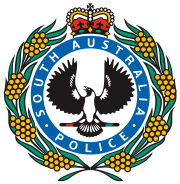 Badge of the South Australia Police | |
 Flag of the South Australia Police | |
| Motto | Keeping South Australia Safe |
| Agency overview | |
| Formed | 28 April, 1838 |
| Employees | 5869 (June 2017)[1] |
| Jurisdictional structure | |
| Operations jurisdiction | South Australia, Australia |
| Headquarters |
100 Angas Street, Adelaide, SA 5000 34°55′36.07″S 138°36′3.25″E / 34.9266861°S 138.6009028°E |
|
| |
| Sworn members | 4948 (June 2017)[1] |
| Police Commissioner responsible |
|
| Units |
List
|
| Facilities | |
| Stations | 138[2] |
| Website | |
| www.police.sa.gov.au | |
The South Australia Police (SAPOL) is the police force of the Australian state of South Australia. It is an agency of the Government of South Australia within the South Australian Department of Justice. SAPOL is directed by the Commissioner of Police, who reports to the Minister for Police. As of 30 June 2017, South Australia Police had 4948 active sworn members, including 339 cadets in training and 132 protective services officers, as well as approximately and 920 civilian staff operating across 28 metropolitan and 110 regional police stations.[1][2].
History
Formally established in 1838 under Henry Inman,[3] the force is the oldest in Australasia and it is the third oldest organised Police Service in the World. Unlike other Australian police forces, which originally employed soldiers or former convicts, the South Australia Police enlisted only volunteers. This occurred because South Australia was the only free colony on the continent.[3]
The early stages of the force
In the early stages of the force, the staffing team consisted of ten mounted constables and ten foot constables under the command of the Inspector Henry Inman.
By 1840, Major Thomas Shouldham O'Halloran was appointed as the first official Commissioner of Police. At this time, SAPOL consisted of one Superintendent, two Inspectors, three Sergeants and 47 Constables divided into foot and mounted sections.
From 1848 to 1867, SAPOL also served as the state fire and rescue service until the South Australian Metropolitan Fire Service was formed. They also supplied the Civil Ambulance Service 1880 til 1954 when it was taken over by the St John Ambulance Service.
Commissioners
| Rank | Name | Post-nominals | Term began | Term ended | Time in appointment | Notes |
|---|---|---|---|---|---|---|
| Inspector (Commander) | Henry Inman | 28 April 1838 | 18 May 1840 | 2 years, 20 days | [4][5] | |
| Commissioner (Major) | Thomas Shuldham O'Halloran | 8 June 1840 | 3 April 1843 | 2 years, 299 days | [6][7] | |
| Commissioner | Boyle Travers Finniss | 13 April 1843 | 12 May 1847 | 4 years, 29 days | [8][9] | |
| Commissioner | George Frederick Dashwood | 12 May 1847 | 31 December 1851 | 4 years, 233 days | [10] | |
| Commissioner | Alexander Tolmer | 28 January 1852 | 29 November 1853 | 1 year, 305 days | [11] | |
| Commissioner (Colonel) | Peter Warburton | 29 November 1853 | 13 February 1867 | 13 years, 76 days | [12] | |
| Commissioner | George Hamilton | 13 February 1867 | 24 May 1882 | 15 years, 100 days | [13] | |
| Commissioner | William John Peterswald | 3 May 1882 | 30 August 1896 | 14 years, 119 days | [14] | |
| Commissioner | Lewis George Madley | ISO, VD | 9 September 1896 | 31 December 1909 | 13 years, 113 days | |
| Commissioner | William Henry Raymond | 1 January 1910 | 30 June 1917 | 7 years, 180 days | ||
| Commissioner | Thomas Edwards | 30 June 1917 | 30 June 1920 | 3 years, 0 days | ||
| Commissioner (Brigadier General) | Sir Raymond Leane | CB, CMG, DSO & Bar, MC, VD | 1 July 1920 | 30 June 1944 | 23 years, 365 days | [15] |
| Commissioner | William Francis Johns | CBE | 1 July 1944 | 1 July 1950 | 6 years, 0 days | [16] |
| Commissioner | Ivor Bren Green | LVO | 1 July 1950 | 10 April 1957 | 6 years, 283 days | [14][17] |
| Commissioner (Brigadier) | John McKinna | CMG, CBE, DSO, LVO, ED | 1 July 1957 | 1 June 1972 | 14 years, 336 days | |
| Commissioner | Harold Salisbury | QPM | 1 June 1972 | 17 January 1978 | 5 years, 230 days | [18] |
| Commissioner | Laurence Draper | QPM | 19 January 1978 | 27 May 1982 | 4 years, 128 days | [19] |
| Commissioner | John Bryan Giles | AO, GM, BEM, QPM | 27 May 1982 | 30 June 1983 | 1 year, 34 days | [20][21][22][23] |
| Commissioner | David Hunt | AO, QPM | 30 June 1983 | 31 December 1996 | 13 years, 184 days | [24][25][26] |
| Commissioner | Malcolm Hyde | AO, APM | 10 February 1997 | 20 July 2012 | 15 years, 161 days | [27][28][29] |
| Commissioner | Gary Burns | BM, APM | 20 July 2012 | 20 July 2015 | 3 years, 0 days | [30][31][32] |
| Commissioner | Grant Stevens | APM | 21 July 2015 | Incumbent | 2 years, 451 days |
Mission and authority
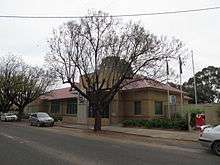
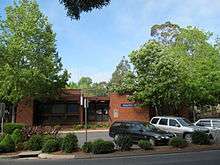
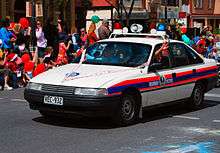


Core services
- Emergency assistance on 000
- Non-urgent assistance on 131 444
- Crime prevention
- Child protection
- Coordinating and managing emergency response
- Responding to domestic violence
- Undertaking police checks
- Preventing vehicle crashes
- Regulating road use
- Registration and licensing of firearms
- Administering expiation notices
- Liquor licensing enforcement
- Statewide security
- Upholding the law.
Services and actions for the state
- Advocacy
- Education
- Community engagement
- Incident response
- Investigation
- Law enforcement
- Prosecution
- Victim support.[33]
Significant changes SAPOL has made to policing
- 1893: Introduced bicycles for metropolitan and country foot police.
- 1893: Pioneered the fingerprint system in Australia.
- 1915: Appointed the first women police in the British Commonwealth - Kate Cocks and Annie Ross
- 1987: The first Australian police service to introduce videotaping of 'suspect person' interviews.
- 1993: Introduced Operation Nomad, as a policing initiative to reduce the threat of bushfires.
- 1996: Crime Stoppers launched.
- 1999: The first Australian policing jurisdiction to appoint a female police officer, Senior Sergeant Jane Kluzek, to a tactical group.
- 2000s: Established Neighbourhood Policing Teams in various metropolitan areas.
- 2011: The first police jurisdiction in Australia to launch its own web platform connecting mobile phone users to the latest police news.
Organisation
SAPOL's structure consists of various units. Through chain of command, all units are accountable to the Commissioner. Services are the largest units, and are headed by a sworn Assistant Commissioner, or for areas which are not policing specific, such as information technology, a civilian Director. Services are directly accountable to either the Commissioner or Deputy Commissioner.[34][35]
Services are based on Local Service Areas (LSA) which provide operational policing services,[36] and Branches, which provide other specialised services or assistance.[37] These areas are further broken down into Sections. Larger sections may be divided into a number of Teams.
Local service areas in South Australia
Local Service Areas are the main organisational unit to provide policing services to the public. A local service area contains a number of police stations, and specialist services to support frontline police such as Detectives, Crime Scene Investigators and Traffic police.[38]
| Northern Operations Service[39] | Southern Operations Service[40] |
| Barossa LSA | Eastern Adelaide LSA |
| Elizabeth LSA | Hills Fleurieu LSA |
| Eyre and Western LSA | Limestone Coast LSA |
| Far North LSA | Murray Mallee LSA |
| Holden Hill LSA | South Coast LSA |
| Yorke Mid-North LSA | Sturt LSA |
| Western Adelaide LSA | |
Each LSA has a designated office known as a 'Complex' where majority of operations in the area start. The LSA then have smaller community police stations for quick policing access.
Divisions and sectors
SAPOL has specific divisions to handle different roles within the organisation. All members of these units are specifically trained for the roles that accompany their division.
- General Operations—Handles all general policing operations.
- Traffic Services—Handles traffic related operations.
- Major Crime Investigations Branch—Investigation and detective unit.
- Special Tasks and Rescue Force—Handles specialised operations that require heavily armed police. They are similar to American SWAT/ Canadian ERT.
- Water Operations Unit—Handles operations in water.
- Dog Operations Unit—Handles operations that require dog assistance.
- Mounted Operations Unit—Operations utilizing Horses.
- Forensic Services Branch—Handles forensics and investigative services.
- Band of the South Australia Police - Provides Musical support to corporate and State functions.
- Public Transport Safety Branch - Handles offences that occur on Public Transport services operating in the Adelaide Metropolitan area[41]
Ranking and structure

| Probationary Constable | Constable | Constable | Senior Constable | Senior Constable First Class | Brevet Sergeant | Sergeant | Senior Sergeant | Senior Sergeant First Class |
 |  |
 |
 |  |  |  |  |  |
|---|
All grades of Constable perform the same basic range of duties, with the rank only reflecting experience. The rank of Probationary Constable is held for the first fifteen months of service. A Constable with one stripe is qualified for promotion to Senior Constable. A Senior Constable First Class is either an officer qualified for promotion to Sergeant/Senior Sergeant or has won a Senior Constable First Class position on merit. A Brevet Sergeant is a temporary designation for an officer in a particular position which would require specialised skills, such as a Detective,
A Sergeant normally manages a team during a shift. A Sergeant may also manage a small country station. A Detective Sergeant is normally in charge of a team in an investigations section. As with a Sergeant, a Detective Sergeant may be the officer in charge of a country CIB unit. A Senior Sergeant is the officer in charge of a section, including traffic, criminal investigation, and operations (uniform). A Senior Sergeant traditionally does more administrative work than active patrol duties.
| Inspector | Chief Inspector | Superintendent | Chief Superintendent | Commander | Assistant Commissioner | Deputy Commissioner | Commissioner |
 |  |  |  |  |  |  |  |
Officers of Police were formerly known as Commissioned Officers. This name was changed as SAPOL Officers no longer receive a Queen's Commission. Officers of Police act primarily as managers and generally do not partake in operational policing. An Inspector is in charge of a section. A Detective Inspector is normally in charge of the whole station CIB. A uniform Inspector is normally in charge of the station's operations.
A Chief Inspector commands a department at station level. A uniform Chief Inspector is in charge of all uniformed officers, regardless of their attachments to assigned areas (e.g. general duties, traffic duties etc.). Some country LSA's have Chief Inspectors as the Regional Commander. A Detective Chief Inspector is in charge of all CIB related matters.
Superintendents, Chief Superintendents and Commanders may be the manager of a Local Service Area or Branch, such as the Major Crime Branch. An LSA Commander is generally a Superintendent. A Chief Superintendent may be the manager of a specialised area, such as a Service Coordination Branch. Few Commanders are appointed. The Industrial Relations Branch has a Commander as its officer in charge.
An Assistant Commissioner is the manager of a Service, such as Northern Operations Service or Crime Service.
The Deputy Commissioner is the assistant to the Commissioner, who commands the force.
Uniform and equipment
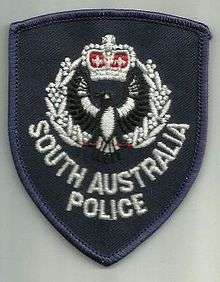
Uniform worn by sworn officers of SAPOL
SAPOL issues uniforms to sworn police officers. Police officers working in non-specialised areas generally wear standard uniform, which consists of a navy blue collared shirt with attached police badges and navy blue slacks. Short and long sleeve shirts are worn as preferred. Police officers can choose between either a dark blue peaked hat, or an Akubra wide brimmed hat and are not required to wear a tie. Baseball caps are worn in specialist areas, including STAR Group, Crime Scene, State Traffic Enforcement Section, and by Operational Safety Trainers. Officers in northern country areas wear khaki uniforms instead of blue.
In 2010 SAPOL started consultations on a new darker uniform reminiscent of those worn by officers of the NYPD. In 2012 SAPOL announced the new uniform would be introduced in mid October 2012 and would be rolled out over 18 months.[43] The only visible change from the consultation period was to the Peaked cap. The white peak was changed to the same dark blue as the shirt and pants, which is called ink blue.
Equipment & Weaponry used by officers
Standard equipment issued to almost all officers are:
- Smith & Wesson M&P .40 S&W Semi Automatic Pistol
- Pepper spray
- ASP Extendable Baton
- Handcuffs
- Taser
- Bodycam (As of January 2018, bodycams are yet to be deployed to all officers.) [44]
Criminal Investigation Officers are issued with the compact version of the semi-automatic pistol (M&Pc). Specialised units such as Special Tasks and Rescue (STAR Group) use other equipment suited to the nature of their duties.
SA Police were among the last to carry revolvers as a duty weapon. They carried Smith & Wesson Model 66 (a variant of the Model 19) revolvers in .357 Magnum until the switch to the Smith & Wesson M&P semi automatic. Victoria also later replaced their .38 special S&W Model 10 revolvers with the Smith & Wesson M&P .40 in 2010.
Vehicles and transportation
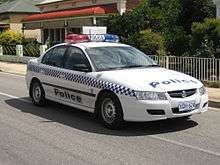
SAPOL officers use a number of vehicles in day-to-day duties. The primary vehicles that are used by patrol members is the Holden Commodore and the Kia Sorento. Also used are Ford, Toyota Camry, Toyota Hilux and Holden Colorado caged vehicles for prisoner transport. In remote country areas, Toyota Land Cruiser Troop Carriers are used as primary patrol vehicles. Patrol cars are used in both marked and unmarked variants, with the latter being a bit more extensive in its vehicle composition. SAPOL have also, in previous years, used high performance vehicles such as Holden's SS Commodore for traffic operations, However, in recent years they have only maintained a fleet of distinctly marked base model Holdens to perform traffic duties.
Members of the State Traffic Enforcement Section ride marked and unmarked Honda and BMW motorcycles for traffic, escort, and other duties.
Usage of police vehicles
SAPOL have the use of several Police Operations Vehicles which are used in a wide variety of ways, for example, as a mobile police station/unit at a large public function, or as forward command posts at search and rescues, or other incidents such as siege or hostage situations. The Special Tasks and Rescue Group (STAR Group) also possess a Lenco BearCat armoured vehicle available for use in siege or terrorist situations.[45]
Specialized operational vehicles
The SAPOL Water Operations Unit uses a number of watercraft to police coastal and inland waterways. Members of STAR Group and Transit Services Branch act as crew members on a Eurocopter EC130 helicopter operated by the Motor Accident Commission Rescue Helicopter Service.[46] Officers also crew other helicopters operated by the MAC Rescue Helicopter Service dependent on the mission. Helicopters are multi-role and are used for search and rescue operations, crime prevention and police pursuits.[46]
For ceremonial activities, crowd control and patrol duties, the SAPOL Mounted Operations Unit use grey horses. They are bred and trained at the Thebarton Police Barracks, in Park 27 of the Adelaide Park Lands, just north-east of the Adelaide city centre. These Police 'Greys' as they are known, are ideal for Police work as the light grey tones make the horse highly visible at night. They are also highly recognisable in the community and are often involved in community events such as leading the annual Credit Union Christmas Pageant and ANZAC day parade.[47]
Training and education
Recruit training is conducted at the SAPOL Police Academy located adjacent to the old barracks adjacent to Fort Largs in the north-western Adelaide suburb of Taperoo. Cadets undergo a 52-week course, called the 'Constable Development Program' (CDP).[48] The CDP is broken down into 5 phases, which includes training at the Police Academy and field experience at metropolitan LSAs.[48] Police cadets learn law, about investigations and police procedures. During recruit training, non-officers (police staff and volunteers) assist with various duties, such as cadet assessment, role playing and general administration. Cadets also undertake operational safety training, including self-defence and the use of firearms. Practical role-playing and assessments are part of the course.[48] Training with police dogs and police horses is offered at the Thebarton Police Barracks. Earlier, training was being held at the older Academy located next to the present one.
Graduation and aftermath for new officers
Cadets graduate with the rank of probationary constable and are subject to a 15-month period of on-the-job training.[49] Probationary Constables are required to work with a Field Tutor for the first 6 months of the probationary period whilst they complete a Personal Learning Portfolio.[49] Probationary Constables also undertake a range of duties to enhance their learning, including traffic, prisoner management, and general duties. For the following 6 months, probationary constables continue to collect evidence of their workplace competency before attended the Probationary Constable Assessment Workshop to determine whether they are suitable to progress to the rank of Constable.[49] Upon completion of the probationary period, officers receive a Diploma of Public Safety (Policing) and are appointed to the rank of Constable.[49]
Training is ongoing and further courses are available for officers to attend, should they wish to progress their policing career further.
SAPOL Protective Security Officers also undergo training at this location. The duration of this training course is only 12 weeks.
Radio communications
SAPOL refers to the communications operation as VKA. At 0400 hours (or 4am) on Tuesday 10 December 2002, SAPOL officially switched from standard 64 UHF channels to the SAGRN. This utilized digital encrypted radio transmissions meaning that scanners could not listen to police communications. While at first there seemed to be technical issues with the new system, they were quickly resolved and the department now has full trust in the system.
SAPOL still have UHF licenses and its plausible they are available as back-up communication channels. SAPOL uses three primary devices for voice communication over the network. They are Spectra W7 mobile, XTS 5000 portable and Spectra W3 mobile. These can be controlled via the RCH3000 desktop controller, used in fixed locations generally by trained operators.
These devices have a number of features that a regularly used in patrols. These features include private call, page alert and telephone interconnect.
Private call allows unit's to directly talk to another unit without dispatch, or other users in the talkgroup to hear. However, this comes with the inability for dispatch to contact either unit. Page function alerts another radio that someone else is attempting to contact them. Telephone interconnect enables units to make and answers calls through the system. However, only supervisors have the ability to make and answer to any number, general patrols are restricted to only a list of certified SAPOL numbers. Each LSA has two assigned 'talkgroups'.
COMCEN (Communications) have assigned talkgroup id's, allowing them to pair a LSA's primary and secondary talkgroups together allowing control to manage two channels at once. The Secondary channel is often used for local/chat, dispatch lowers the volume of the secondary channel which enables them to monitor the channels and talk to all units on duty in the LSA.[50]
Call signs and unit designation identification system
SAPOL use location-based call signs. Units are called in by stating the station they come from followed by a designated number.
Examples:
- A unit in Holden Hill could be Holden Hill 16.
- Traffic Services place a zero (0) before the number. E.g. Holden Hill 016 would be a traffic patrol in Holden Hill with the call sign 16.
- Higher-ranked officers have a different prefix. This is followed after the station name, and before the unit number:
- Sergeant = Vixen
- Senior Sergeant = Mitre
- Inspector / Chief Inspector = Trojan
- Superintendent / Chief Superintendent = Baron
- Example: Holden Hill Mitre 10 is a Senior Sergeant in Holden Hill with the unit number 10.[51]
References
- 1 2 3 "Annual Report 2016 – 2017". www.police.sa.gov.au. South Australia Police. 29 September 2017. Retrieved 28 March 2018.
- 1 2 "Who We Are". South Australia Police. Retrieved 28 March 2018.
- 1 2 "South Australia Police Historical Society". South Australia Police Historical Society. Retrieved 9 June 2011.
- ↑ Position titled 'Officer in Charge of the South Australia Police Force'.
- ↑ Max Slee Inman : first commander of the South Australia Police, Seaview Press (Adelaide 2010) ISBN 978-1-74008-559-5.
- ↑ First to be titled 'Commissioner'. Resigned in order to serve as Police Magistrate.
- ↑ Bruce Ross, D. (1967). "Finniss, Boyle Travers (1807–1893)". Australian Dictionary of Biography. National Centre of Biography, Australian National University. Retrieved 17 March 2015.
- ↑ Later the first Premier of South Australia.
- ↑ "Finniss, Boyle Travers (1807–1893)". Australian Dictionary of Biography. National Centre of Biography, Australian National University. 1966. Retrieved 17 March 2015.
- ↑ Member of Legislative Council
- ↑ A veteran of the Portuguese Liberal Wars (1828-1834), Tolmer had been awarded by Queen Maria II of Portugal with the Knight of the Order of the Tower and Sword.
- ↑ Dismissed from office.
- ↑ J. H. Love (2005). "Hamilton, George (1812–1883)". Australian Dictionary of Biography. National Centre of Biography, Australian National University. Retrieved 17 March 2015.
- 1 2 Died in office.
- ↑ Crushed the Port Adelaide wharf strike of 1928. Knighted in 1945.
- ↑ "JOHNS, William Francis - Commander of the Order of the British Empire". It's an honour database. Australian Government. 1 January 1946. Retrieved 17 March 2015.
- ↑ "GREEN, Ivor Bren - Lieutenant of the Royal Victorian Order". It's an honour database. Australian Government. 27 April 1954. Retrieved 17 March 2015.
In recognition of service during the 1954 Royal Visit
- ↑ Dismissed by Premier Don Dunstan for misleading parliament about the existence of the Special Branch and the information it had collected, particularly on Australian Labor Party politicians and the 'pink files' on known homosexuals.
- ↑ "DRAPER, Laurence Desmond - Queen's Police Medal". It's an honour database. Australian Government. Retrieved 17 March 2015.
- ↑ "GILES, John Bryan - Officer of the Order of Australia". It's an honour database. Australian Government. 26 January 1984. Retrieved 17 March 2015.
For public service in the South Australian Police Force
- ↑ "GILES, John Bryan - George Medal". It's an honour database. Australian Government. 29 July 1952. Retrieved 17 March 2015.
South Australia Police: Apprehend an armed man
- ↑ "GILES, John Bryan - British Empire Medal". It's an honour database. Australian Government. 25 September 1962. Retrieved 17 March 2015.
GALLANTRY:SA Police: Disarm deranged man
- ↑ "GILES, John Bryan - Queen's Police Medal". It's an honour database. Australian Government. 1 January 1968. Retrieved 17 March 2015.
- ↑ "Former SA police commissioner dies". Australian Broadcasting Corporation. ABC News. 12 October 2010. Retrieved 17 March 2015.
- ↑ "HUNT, David Alexander - Officer of the Order of Australia". It's an honour database. Australian Government. 10 June 1994. Retrieved 17 March 2015.
For service to the South Australian Police Department and to the community.
- ↑ "HUNT, David Alexander - Queen's Police Medal". It's an honour database. Australian Government. 31 December 1980. Retrieved 17 March 2015.
- ↑ AAP (7 March 2012). "SA's top cop Mal Hyde to retire". Herald Sun. Retrieved 17 March 2015.
- ↑ "HYDE, Malcolm Arthur - Officer of the Order of Australia". It's an honour database. Australian Government. 9 June 2008. Retrieved 17 March 2015.
For service to policing and law enforcement as Commissioner of Police in South Australia, particularly through the development of improved service delivery methods, to the detection and prevention of illicit drug use and electronic crime, and through contributions to national law enforcement policies.
- ↑ "HYDE, Malcolm Arthur - Australian Police Medal". It's an honour database. Australian Government. 26 January 1995. Retrieved 17 March 2015.
- ↑ AAP (2 August 2012). "Gary Burns is new SA police chief". The Australian. Retrieved 17 March 2015.
- ↑ "BURNS, Gary Thomas - Bravery Medal". It's an honour database. Australian Government. 16 September 1977. Retrieved 17 March 2015.
Rescued elderly women from burning flats
- ↑ "BURNS, Gary Thomas - Australian Police Medal". It's an honour database. Australian Government. 26 January 2003. Retrieved 17 March 2015.
- ↑ https://www.police.sa.gov.au/about-us/who-we-are
- ↑ "South Australia Police - Structure". South Australia Police. Retrieved 9 June 2011.
- ↑ "South Australia Police - Services Structure". South Australia Police. Retrieved 9 June 2011.
- ↑ "South Australia Police - Southern Operations Service". South Australia Police. Retrieved 9 June 2011.
- ↑ "South Australia Police - Crime Service". South Australia Police. Retrieved 9 June 2011.
- ↑ "Eastern Adelaide LSA". South Australia Police. Retrieved 10 June 2011.
The LSA provides a range of services including Operations, Traffic, CIB, Intelligence and Crime Prevention.
- ↑ "Northern Operations Service". South Australia Police. Retrieved 10 June 2011.
- ↑ "Southern Operations Service". South Australia Police. Retrieved 10 June 2011.
- ↑ "Public Transport Safety Branch". police.sa.gov.au. South Australia Police. 28 August 2014. Retrieved 19 August 2016.
- 1 2 "South Australia Police - Rank Insignia". The International Encyclopedia of Uniform Insignia Around the World. Retrieved 30 December 2007.
- ↑ "South Australian police uniform gets an update". Herald Sun. Retrieved 5 October 2012.
- ↑ https://www.police.sa.gov.au/sa-police-news-assets/front-page-news/body-worn-video-coming-to-a-police-officer-near-you#.WQ7lDYh96Uk
- ↑ "SAPOL's latest security weapon". SA Police News. Retrieved 9 June 2011.
- 1 2 "MAC Rescue Helicopter". Motor Accident Commission of SA. Retrieved 9 June 2011.
- ↑ "Special Tasks and Rescue Group". South Australia Police. Retrieved 10 June 2011.
- 1 2 3 "Achieve More". South Australia Police Recruiting Section. Retrieved 13 June 2011.
- 1 2 3 4 "Achieve More". South Australia Police Recruiting Section. Retrieved 13 June 2011.
- ↑ http://www.sascan.net.au/?page=infPages/infPolice
- ↑ http://www.sascan.net.au/?page=infPages/policeCallsigns
